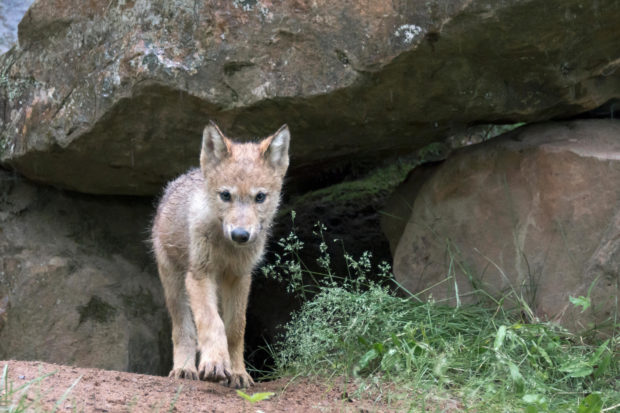Last month, a federal agent placed an M-44 cyanide bomb on public lands in eastern Idaho. As intended, it detonated, but the agent missed his target and claimed a couple of unintended victims: a 14-year-old boy, Canyon Mansfield, was sprayed as the poison shot out of the explosive device. He survived, but his dog Casey, who was also sprayed, didn’t.
Days before, M-44s killed two more dogs – Molly and Abby– in Wyoming when they were out for a hike with their family (including a child).
In yet another incident, an M-44 recently detonated and killed a protected gray wolf in Oregon.
The steady stream of wildlife deaths caused by M-44s rarely makes the news, partly because it’s been going on for so long. But when a human or pet triggers the devices, people sit up and take note. These incidents then, tragic as they are, force all of us to take a fresh look at a government program that is as obscure as it is deadly.
The big-picture story here is that our own U.S. Department of Agriculture houses a program whose agents kill millions of wild animals a year at taxpayer expense, and endanger citizens.
The government is supposed to be the protector of animals, not the persecutor, and the USDA’s Wildlife Services has long been a program with the wrong mission and wrong execution. Too much execution, in fact.
That’s why we need a grand solution. This week, The HSUS and other wildlife protection groups filed a federal lawsuit seeking to compel the U.S. Fish and Wildlife Service to conduct a long-overdue review of some of the lethal and indiscriminate poisons used by the Wildlife Services program to kill wild animals, including sodium cyanide (used in M-44s) and Compound 1080. The EPA – recognizing the dire threat these chemicals pose to non-target endangered animals – requested this consultation more than six years ago, but the poisons continue to be routinely used without proper scientific analysis, allowing them to litter western landscapes shared with wolves, grizzly bears, lynx, and dogs.
We are hopeful that the court will look at the record and order the USDA to stop using these poisons. But that’s not the only front of action. After the recent wolf poisoning, the federal government agreed to eliminate the use of M-44s from six eastern Oregon counties. Just last week, Congressman Peter DeFazio, D-Ore., introduced a bill to ban sodium cyanide M-44s and Compound 1080 everywhere in the United States.

An M-44 recently detonated and killed a protected gray wolf in Oregon. In response, the federal government agreed to eliminate the use of M-44s from six eastern Oregon counties. But that won’t protect wolves who roam outside of those counties. Photo by Alamy
The M-44 device is a metal tube, about the size of a tent stake. It is topped with a smelly bait designed to lure wild carnivores such as coyotes. The metal tube contains a piston mechanism that, when triggered, plunges into a polyethylene capsule of sodium cyanide. The powdered cyanide sprays into the mouth of the victim where it mixes with saliva and turns into deadly cyanide gas that is readily absorbed into the lungs, causing asphyxiation. Cyanide is the substance that the Nazis used in gas chambers during the Holocaust. It is one of the most acutely toxic substances on earth and yet, Wildlife Services routinely uses this poison in more than a dozen states. Only a few of these states prohibit the placement of sodium cyanide M-44s on their public lands.
Like leghold traps and cable neck snares, M-44s do not discriminate between “target” (e.g. coyotes, foxes) and “non-target” (e.g. people, family pets, wolves, bears, cattle, and bald eagles) victims. And the death toll from M-44s is staggering. Wildlife Services data show that in the last year alone, M-44s killed 13,208 animals, including hundreds of non-target species such as dogs, foxes, raccoons, opposums, and skunks, in addition to the thousands of coyotes and other target species killed each year. In just one state (Texas) in 2016, Wildlife Services intentionally killed 4,738 animals with M-44s, including 4,210 coyotes, 466 gray foxes, and 56 red foxes. Of course, those are the agency’s numbers, and given its penchant for hiding data and its near-obsession with avoiding public accountability, we have every reason to suspect it drastically under-reports the number of animals that die – intentionally or otherwise – in the course of its operations.
There is simply no reason for the federal government to keep spending millions of dollars every year to use poisons to kill wildlife, on behalf of a small group of ranchers who can use alternative methods of mitigating conflicts. If President Trump is serious about slashing wasteful government spending, the Wildlife Services program would be a good place to start.
The post Taking USDA’s Wildlife Services program to court appeared first on A Humane Nation.
Enviroshop is maintained by dedicated NetSys Interactive Inc. owners & employees who generously contribute their time to maintenance & editing, web design, custom programming, & website hosting for Enviroshop.
